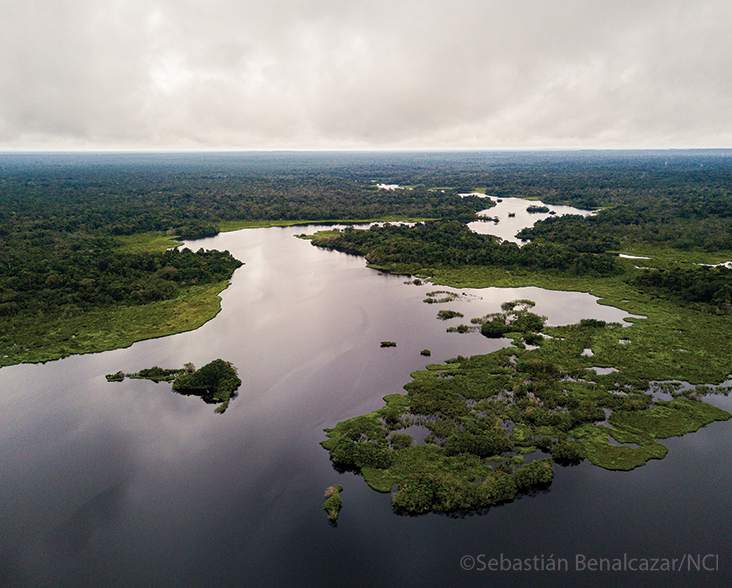South American River Turtle
Species Data
Class: Reptilia
Order: Testudines
Family: Phyllomedusidae
Scientific Name: Podocnemis expansa
IUCN Red List status: Lower Risk/Conservation Dependent
Description
Measuring up to 107 cm in length, the South American River Turtle, or Arrau Sideneck Turtle, is the largest river turtle in Latin America. The adult carapace is flattened and broad, widest from posterior to behind the centre, has a smooth posterior rim and posterior marginal scutes (plates made of keratin) flared over the limbs. A medial keel on the carapace is usually absent, and the carapacial scutes usually lack ridges or raised growth rings. On the underside, the plastron, marginals, and bridge (where the carapace and plastron join) are yellow. The broad head has a protruding snout, a squared-off upper jaw that is not notched in front, usually two barbels on the chin near the front of the lower jaw, and no subocular scales. The neck is grey with yellow on the ventral surface, and the carapace is olive to dark grey or brown, with younger individuals often having dark spots and a light border. This species is sexually dimorphic. Males differ from females by having a longer, thicker tail and a more rounded head with yellow markings.
Behaviour
This mainly herbivorous species feeds during the day, mostly during the high-water season, eating very little during the dry season. Their diet includes tree fruits and seeds found on the floor of flooded forests and legumes, green leaves, flowers and roots of aquatic plants. However, they will also eat freshwater sponges and eggs and scavenge dead fish.
Nesting occurs at the start of the low-water season when males and females migrate from flooded forests and gather at nesting sites. After mating in the water, females spend up to six hours a day basking for several weeks to aid egg development. Nesting happens at night when females leave the water and make their way onto a low sand beach or sandbar liable to flooding, where they excavate a body pit of 80-100 cm before digging the 75-80 cm nest at the bottom of the pit. Each female lays 78-132 leathery-shelled spherical eggs 32-54 mm in diameter, with several females laying in the same nest when nest sites are crowded. The temperature at which the eggs are incubated determines the sex of the hatchlings. At higher temperatures, embryos develop into females, and at lower temperatures, into males.
This species is known for its parental behaviour, which is unique among turtles. After laying, the females congregate in shallow waters at the nesting sites for around 50 days until the eggs hatch. The young start calling a few hours before hatching, and after emerging from their nest, immediately head to the water where their calling mothers are waiting. As water levels rise, the females and hatchlings migrate with the males back to the flooded forests.
Females become sexually mature at around 4-5 years. It is estimated this species lives for over 20 years in the wild.


Habitat
The South American River Turtle inhabits blackwater and whitewater rivers and tributaries in the Amazon, Orinoco and Esequibo river basins. In the high-water season, they move into flooded forests, adjacent lagoons and ponds, retreating to rivers during the low-water season. Their distribution includes Amazonian Brazil, Bolivia, Colombia, Ecuador and Peru; Guyana and Venezuela. They also occur in Trinidad and Tobago after floods in the Orinoco River.
Threats and Conservation
In the 19th century, this species’ population was estimated in the millions, but more than 200 years of unsustainable large-scale commercialised hunting has drastically decreased numbers across their range. Adult turtles, mainly females, were hunted in enormous quantities for meat and eggs, as well as for fat to be rendered for street lighting and cooking oil (including export to Europe). In the 1800s, hunters in Peru could take up to 1,000 turtles in one night, while in the Brazilian Amazon, 48 million eggs were harvested during 1848-1859. Conservation efforts for the South American River Turtle began in the 1960s, and although this species is listed in CITES Appendix II, hunting remains intensive.
Other threats include water releases from hydroelectric dams that flood nesting sites, dredging by mining companies, and noise pollution from mining and motorised watercraft interfering with turtle communication. Climate change also affects breeding success by changing rainfall patterns and altering water levels, preventing nesting beaches from being exposed and flooding nests before eggs hatch.
Categorised as Lower Risk/Conservation Dependent on the IUCN Red List, there is no accurate estimate of the current global population of the South American River Turtle; however, it is far lower than historical population size estimates. Protecting nesting sites and coordinated global conservation measures are vital in safeguarding this species and preventing further population declines.
